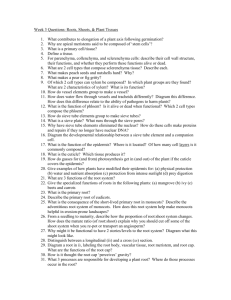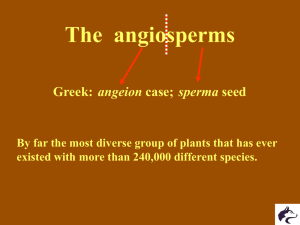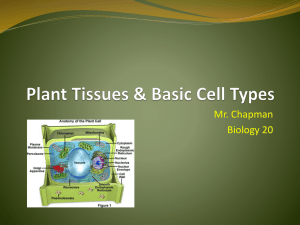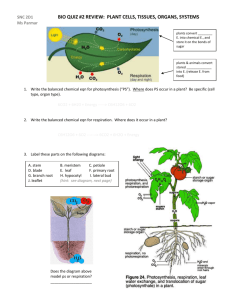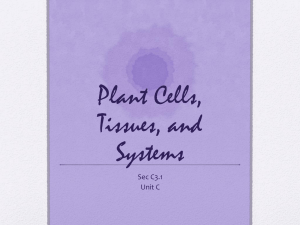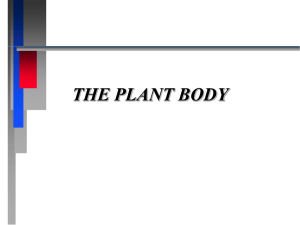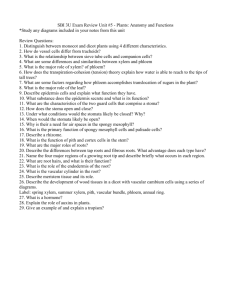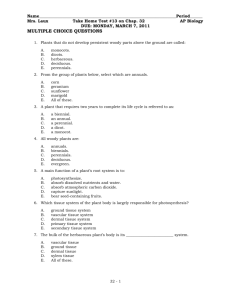PANEL 22–2: The Cell Types and Tissues
advertisement
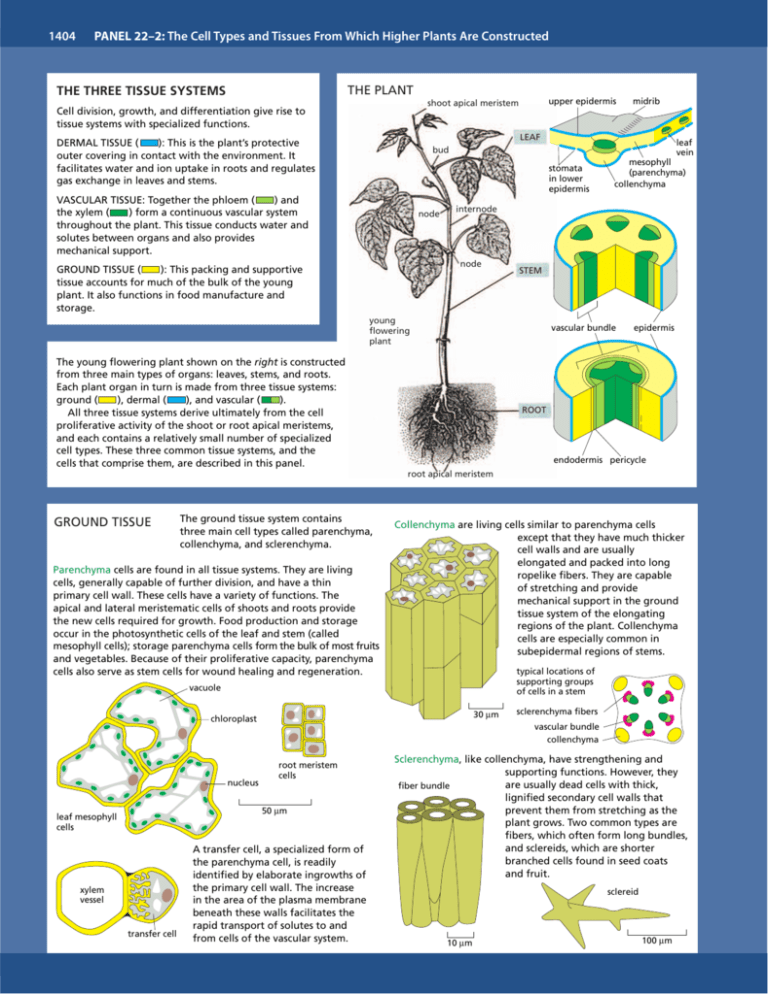
1404 PANEL 22–2: The Cell Types and Tissues From Which Higher Plants Are Constructed THE PLANT THE THREE TISSUE SYSTEMS upper epidermis shoot apical meristem Cell division, growth, and differentiation give rise to tissue systems with specialized functions. midrib LEAF DERMAL TISSUE ( ): This is the plant’s protective outer covering in contact with the environment. It facilitates water and ion uptake in roots and regulates gas exchange in leaves and stems. leaf vein bud stomata in lower epidermis VASCULAR TISSUE: Together the phloem ( ) and the xylem ( ) form a continuous vascular system throughout the plant. This tissue conducts water and solutes between organs and also provides mechanical support. node internode node GROUND TISSUE ( ): This packing and supportive tissue accounts for much of the bulk of the young plant. It also functions in food manufacture and storage. mesophyll (parenchyma) collenchyma STEM young flowering plant vascular bundle The young flowering plant shown on the right is constructed from three main types of organs: leaves, stems, and roots. Each plant organ in turn is made from three tissue systems: ground ( ), dermal ( ), and vascular ( ). All three tissue systems derive ultimately from the cell proliferative activity of the shoot or root apical meristems, and each contains a relatively small number of specialized cell types. These three common tissue systems, and the cells that comprise them, are described in this panel. epidermis ROOT endodermis pericycle root apical meristem GROUND TISSUE The ground tissue system contains three main cell types called parenchyma, collenchyma, and sclerenchyma. Parenchyma cells are found in all tissue systems. They are living cells, generally capable of further division, and have a thin primary cell wall. These cells have a variety of functions. The apical and lateral meristematic cells of shoots and roots provide the new cells required for growth. Food production and storage occur in the photosynthetic cells of the leaf and stem (called mesophyll cells); storage parenchyma cells form the bulk of most fruits and vegetables. Because of their proliferative capacity, parenchyma cells also serve as stem cells for wound healing and regeneration. Collenchyma are living cells similar to parenchyma cells except that they have much thicker cell walls and are usually elongated and packed into long ropelike fibers. They are capable of stretching and provide mechanical support in the ground tissue system of the elongating regions of the plant. Collenchyma cells are especially common in subepidermal regions of stems. typical locations of supporting groups of cells in a stem vacuole 30 µm chloroplast nucleus vascular bundle collenchyma root meristem cells 50 µm leaf mesophyll cells xylem vessel transfer cell sclerenchyma fibers A transfer cell, a specialized form of the parenchyma cell, is readily identified by elaborate ingrowths of the primary cell wall. The increase in the area of the plasma membrane beneath these walls facilitates the rapid transport of solutes to and from cells of the vascular system. Sclerenchyma, like collenchyma, have strengthening and supporting functions. However, they are usually dead cells with thick, fiber bundle lignified secondary cell walls that prevent them from stretching as the plant grows. Two common types are fibers, which often form long bundles, and sclereids, which are shorter branched cells found in seed coats and fruit. sclereid 10 µm 100 µm 1405 DERMAL TISSUE Stomata guard cells The epidermis is the primary outer protective covering of the plant body. Cells of the epidermis are also modified to form stomata and hairs of various kinds. Epidermis waxy layer air space The epidermis (usually one layer of cells deep) covers the entire stem, leaf, and root of the young plant. The cells are living, have thick primary cell walls, and are covered on their outer surface by a special cuticle with an outer waxy layer. The cells are tightly interlocked in different patterns. upper epidermis of a leaf epidermis 100 µm hair 5 µm cuticle Stomata are openings in the epidermis, mainly on the lower surface of the leaf, that regulate gas exchange in the plant. They are formed by two specialized epidermal cells called guard cells, which regulate the diameter of the pore. Stomata are distributed in a distinct species-specific pattern within each epidermis. young, single-celled hairs in the epidermis of the cotton seed. When these grow, the walls will be secondarily thickened with cellulose to form cotton fibers. epidermis Vascular bundles Roots usually have a single vascular bundle, but stems have several bundles. These are arranged with strict radial symmetry in dicots, but they are more irregularly dispersed in monocots. 50 µm Hairs (or trichomes) are appendages derived from epidermal cells. They exist in a variety of forms and are commonly found in all plant parts. Hairs function in protection, absorption, and secretion; for example, sheath of sclerenchyma epidermis of a stem root hair 10 µm a multicellular secretory hair from Single-celled root hairs a geranium leaf have an important function in water and ion uptake. phloem VASCULAR TISSUE xylem parenchyma The phloem and the xylem together form a continuous vascular system throughout the plant. In young plants they are usually 50 mm associated with a variety of other cell types a typical vascular bundle from in vascular bundles. Both phloem and the young stem of a buttercup xylem are complex tissues. Their conducting elements are associated with parenchyma cells that maintain the elements and exchange materials with them. In addition, groups of collenchyma and sclerenchyma cells provide mechanical support. Phloem sieve plate companion cell sieve pore plasma membrane 50 µm small vessel element in root tip sieve area external view of sieve-tube element Xylem Xylem carries water and dissolved ions in the plant. The main conducting cells are the vessel elements shown here, which are dead cells at maturity that lack a plasma membrane. The cell wall has been secondarily thickened and heavily lignified. As shown below, its end wall is largely removed, enabling very long, continuous tubes to be formed. large, mature vessel element sieve-tube element in cross-section Phloem is involved in the transport of organic solutes in the plant. The main conducting cells (elements) are aligned to form tubes called sieve tubes. The sieve-tube elements at maturity are living cells, interconnected by perforations in their end walls formed from enlarged and modified plasmodesmata (sieve plates). These cells retain their plasma membrane, but they have lost their nuclei and much of their cytoplasm; they therefore rely on associated companion cells for their maintenance. These companion cells have the additional function of actively transporting soluble food molecules into and out of sieve-tube elements through porous sieve areas in the wall. The vessel elements are closely associated with xylem parenchyma cells, which actively transport selected solutes into and out of the elements across the parenchyma cell plasma membrane. xylem parenchyma cells vessel element

